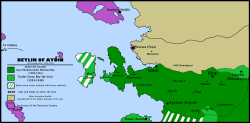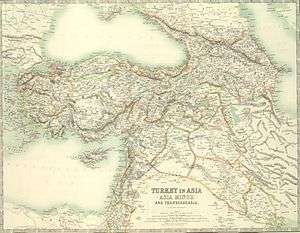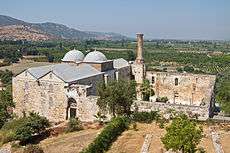Aydınids
The Aydinids or Aydinid dynasty (Modern Turkish: Aydınoğulları, Aydınoğulları Beyliği), also known as the Principality of Aydin and Beylik of Aydin (Aydın Beyliği), was one of the Anatolian beyliks and famous for its seaborne raiding.
Beylik of Aydin Aydınoğulları | |||||||||
|---|---|---|---|---|---|---|---|---|---|
| 1308–1426 | |||||||||
 Flag | |||||||||
 Beylik of Aydın's Map during its peak (1315-1375) highlighting: Borders under Gazi Mehmed Bey Borders after conquests under Umur Bey the Lion Byzantine Empire territories Other Western Anatolian Beyliks Black "X" showing Umur Bey's aids Red "X" showing Umur Bey's raids | |||||||||
| Capital | Birgi, Selçuk | ||||||||
| Common languages | Turkish | ||||||||
| Religion | Islam | ||||||||
| Government | Beylik | ||||||||
| History | |||||||||
• Collapse of the Sultanate of Rum | 1308 | ||||||||
• Annexation by the Ottoman Empire | 1426 | ||||||||
| |||||||||
| Today part of | Turkey | ||||||||
Part of a series on the |
||||||||||||||||||||||||||||||||||||||||
|---|---|---|---|---|---|---|---|---|---|---|---|---|---|---|---|---|---|---|---|---|---|---|---|---|---|---|---|---|---|---|---|---|---|---|---|---|---|---|---|---|
| History of Turkey | ||||||||||||||||||||||||||||||||||||||||
 | ||||||||||||||||||||||||||||||||||||||||
|
||||||||||||||||||||||||||||||||||||||||
|
||||||||||||||||||||||||||||||||||||||||
|
||||||||||||||||||||||||||||||||||||||||
|
||||||||||||||||||||||||||||||||||||||||
|
||||||||||||||||||||||||||||||||||||||||
|
||||||||||||||||||||||||||||||||||||||||
|
| ||||||||||||||||||||||||||||||||||||||||

Name
It is named after its founder Aydın Mehmed Bey.
Capital
Its capital was at first in Birgi, and later in Ayasoluk (present day Selçuk), was one of the frontier principalities established in the 14th century by Oghuz Turks after the decline of Sultanate of Rûm.
History
The Aydinids also held parts of the port of Smyrna (modern İzmir) all through their rule and all of the port city with intervals. Especially during the reign of Umur Bey, the sons of Aydın were a significant naval power of the time.[1] The naval power of Aydin played a crucial role in the Byzantine civil war of 1341–1347, where Umur allied with John VI Kantakouzenos, but also provoked a Latin response in the form of the Smyrniote crusades, that captured Smyrna from the beylik.
The Beylik was incorporated into the Ottoman Empire for the first time in 1390, and after the passage of Tamerlane in Anatolia in 1402 and the ensuing period of troubles that lasted until 1425, its territories became again part of the Ottoman realm, this time definitively.
Architecture
The Beys of Aydin left important architectural works, principally in Birgi and Ayasoluk (Selçuk), their capital cities.
Legacy
The city of Aydın (ancient Tralles) was named after the dynasty.
List of Rulers
- Muharizalsîn Gazi Mehmed Bey (1308-1334)[2]
- Umur Bey (1334-1348)[2]
- Khidr b. Mehmed (1348-1360)[2]
- Isa b. Mehmed(1360-1390)[2]
- Ottoman rule (1390-1402)
- İsaoğlu Musa Bey (1402-1403)
- Musaoğlu II. Umur Bey (1403-1405)
- İzmiroğlu Cüneyd Bey (1405-1426)
See also
- İsa Bey Mosque
- Anatolian beyliks
- Ottoman Empire
- List of Sunni Muslim dynasties
- Umur the Lion
- Cüneyt Bey of Aydın
References
- Hans Theunissen. "Venice and the Turkoman Begliks of Menteşe and Aydın" (PDF). Utrecht University. Archived from the original (PDF) on 2008-02-27.
- C.E. Bosworth, The New Islamic Dynasties, (Columbia University Press, 1996), 221.
Bibliography
- İnalcık, Halil (1993). "The Rise of the Turcoman Maritime Principalities in Anatolia, Byzantium, and the Crusades" (PDF). The Middle East & the Balkans Under the Ottoman Empire: Essays on Economy & Society. Indiana University Turkish Studies Department. pp. 309–341. ISBN 1878318047.
- Lemerle, Paul (1957). L'émirat d'Aydin, Byzance et l'Occident: Recherches sur la "Geste d'Umur Pacha". Bibliothèque byzantine: Etudes No. 2 (in French). Paris: Presses Universitaires de France.
- Mélikoff, Irene (1986). "Aydi̊̊n-Og̲h̲lu". The Encyclopedia of Islam, New Edition, Volume I: A–B. Leiden and New York: BRILL. ISBN 90-04-08114-3.
- Uzunçarşılı, İsmail Hakkı (1984). Anadolu Beylikleri ve Akkoyunlu, Karakoyunlu Devletleri (in Turkish). Ankara: Türk Tarih Kurumu Basımevi. pp. 104–120. OCLC 563553149.
- Zachariadou, Elisabeth A. (1983). Trade and crusade: Venetian Crete and the beyliks of Menteshe and Aydin (1300-1415). Venice: Istituto Ellenico di Studi Bizantini e Post-bizantini di Venezia. OCLC 144691037.